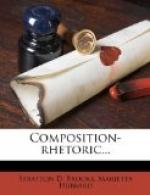+46. Details Related in Time-Order.+—The experiences of daily life follow each other in time, and when we read of a series of events we at once think of them as having occurred in a certain time-order. To assist in establishing the correct time-order, the writer should generally state the details of his story in the order in which they occurred. The method of showing time relations for simultaneous events has been discussed in Section 11.
If the narrative is of considerable length, it may be divided into paragraphs, each dealing with some particular stage of its progress. The time relations among the sentences within the paragraph and among the paragraphs themselves should be such that the reader may readily follow the thread of the story to its main point. Narrative paragraphs often do not have topic sentences.
In the following selection from Black Beauty notice how the time relations give unity of thought both to the paragraphs and to the whole selection:—
He hung my rein on one of the iron spikes, and was soon hidden among the trees. Lizzie was standing quietly by the side of the road, a few paces off, with her back to me. My young mistress was sitting easily, with a loose rein, humming a little song. I listened to my rider’s footsteps until he reached the house, and heard him knock at the door.
There was a meadow on the opposite side of the road, the gate of which stood open. As I looked, some cart horses and several young colts came trotting out in a very disorderly manner, while a boy behind was cracking a great whip. The colts were wild and frolicsome. One of them bolted across the road and blundered up against Lizzie. Whether it was the stupid colt or the loud cracking of the whip, or both together, I cannot say, but she gave a violent kick and dashed off into a headlong gallop. It was so sudden that Lady Anne was nearly unseated, but she soon recovered herself.
I gave a long, shrill neigh for help. Again and again I neighed, pawing the ground impatiently, and tossing my head to get the rein loose. I had not long to wait. Blantyre came running to the gate. He looked anxiously about, and just caught sight of the flying figure now far away on the road. In an instant he sprang to the saddle. I needed no whip, no spur, for I was as eager as my rider. He saw it; and giving me a free rein, and leaning a little forward, we dashed after them.
For about a mile and a half the road ran straight, then bent to the right; after this it divided into two roads. Long before we came to the bend my mistress was out of sight. Which way had she turned? A woman was standing at her garden gate, shading her eyes with her hand, and looking eagerly up the road. Scarcely drawing rein, Lord Blantyre shouted, “Which way?” “To the right!” cried the woman, pointing with her hand, and away we went up the right-hand road. For a moment we caught sight of Lady Anne; another bend, and she was hidden again. Several times we caught glimpses of the flying rider, only to lose her again. We scarcely seemed to gain ground upon her at all.




